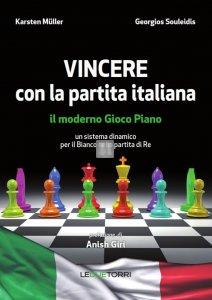The Italian Opening for White
Bargsten Justus

The Italian Opening is one of the oldest in chess history, mentioned as early as the 15th century, but is still a frequent guest today, even at the highest level, most recently in the 2021 world championship match between Magnus Carlsen and Ian Nepomniachtchi. Although the challenger lost this game, the use of the Italian Opening alone shows that it's a serious weapon even among top grandmasters.
Descrizione
The Italian Opening is one of the oldest in chess history, mentioned as early as the 15th century, but is still a frequent guest today, even at the highest level, most recently in the 2021 world championship match between Magnus Carlsen and Ian Nepomniachtchi. Although the challenger lost this game, the use of the Italian Opening alone shows that it's a serious weapon even among top grandmasters.
Many white players choose it because they want to obtain a substantial game. The positions are often less concrete and tactical than in other openings, and because they are also less analyzed, the modern Italian offers a good mix of uncharted territory and positional understanding.
With this work, the author aims to illustrate the modern ideas of the Italian Opening to players at a medium level. It deals with positions based on White's 'slow' plan, i.e. if he chooses a calm approach characterized by positional ideas. The author does not attempt to offer the reader a complete repertoire, but rather to explain the ideas of the emerging middlegame positions.
The material primarily includes the systems 1.e4 e5 2.Nf3 Nc6 3.Bc4 Nf6 4.d3 Bc5 5.c3 h6 6.0–0 d6 7.Re1 a6 8.a4 Ba7 9.Nbd2 0–0 10.h3 and 1.e4 e5 2.Nf3 Nc6 3.Bc4 Nf6 4.d3 Bc5 5.c3 d6 6.0–0 0–0 7.h3 h6 8.Re1 a5, where especially the latter has gained enormous popularity in current practice.
Informazioni
- Casa editrice Joachim Beyer Verlag
- Codice 8176
- Anno 2023
- Pagine 122
- Isbn 9783959209533
 Italiano
Italiano
 English
English


